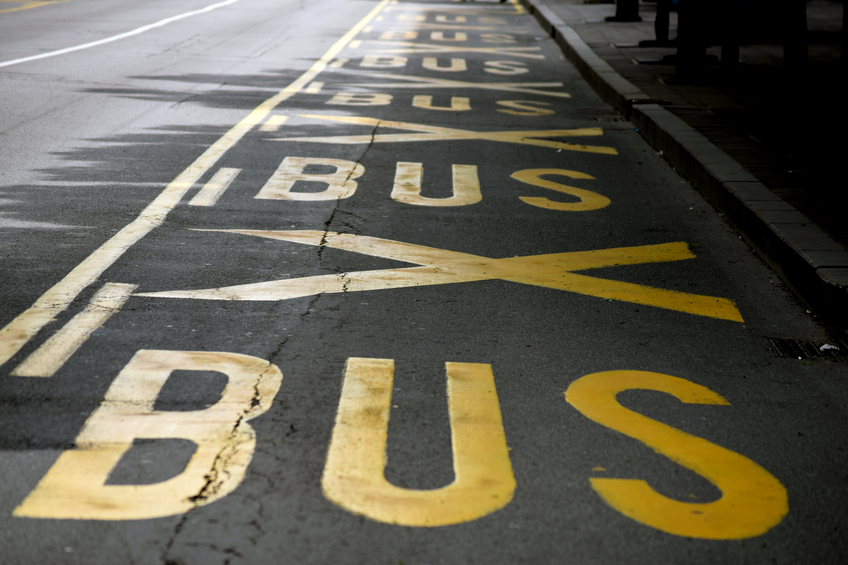South Dakota Transportation 30 PDH Discount Package 2
Courses in this Package
Low-Cost Treatments for Horizontal Curve Safety (C08-020)
Geometric Design for Roads, Streets, Walks and Open Storage Areas (C03-018)
Managed Freeway Lanes (C04-011)
Minimum Retroreflectivity Levels for Blue and Brown Traffic Signs (C04-046)
Ramp Management Strategies (C04-010)
Roundabout Geometric Design (C04-004)
Roundabout Traffic Design and Landscaping (C03-010)

This online PDH course primarily covers engineering countermeasures for horizontal curve safety that are relatively low-cost, such as signage and pavement markings.
This course is intended to provide information specifically relating to lower volume two-lane roads and the agencies that manage them. It will help transportation agencies and their crews understand the available countermeasures and how to select and apply them.
This 8 PDH online course is applicable to traffic engineers, local transport agencies, design professionals and personnel who wish to understand the available horizontal curve safety countermeasures and how to select and apply them.
This PE continuing education course is intended to provide you with the following specific knowledge and skills:
- Learning about the two components of safety improvements
- Familiarization with the markings, signs, and pavement countermeasures that are used to improve horizontal curve safety
- Addressing the importance of roadside conditions and improvement opportunities
- Familiarization with the possible means of improving intersections
Upon successful completion of the quiz, print your Certificate of Completion instantly. (Note: if you are paying by check or money order, you will be able to print it after we receive your payment.) For your convenience, we will also email it to you. Please note that you can log in to your account at any time to access and print your Certificate of Completion.

This online engineering PDH course refers to military design requirements and objectives and provides guidance on the general provisions and geometric design criteria for the design of roads, streets, bridges, walks, parking, residence drives and storage areas. It discusses how geometric design deals with the dimensions of the visible features of a facility such as alignment, sight distances, widths, slopes, and grades.
This 3 PDH online course is applicable to civil and traffic engineers, technical professionals and construction personnel who are interested in gaining a better understanding of geometric design for roadways, walkways and open storage areas.
This PE continuing education course is intended to provide you with the following specific knowledge and skills:
- Understanding the purpose, scope and definitions of geometric design
- Understanding the general provisions for access highway and installation highway design
- Understanding the design basis for roads, streets and storage areas
- Understanding the principles of geometric design for underpass roadways, bridges, walks, parking and residence drives
In this professional engineering CEU course, you need to review the course document titled "General Provisions and Geometric Design for Roads, Streets, Walks and Open Storage Areas" prepared by the Department of Defense, Unified Facilities Criteria Publication "UFC 3-250-18FA", January 2006.
Upon successful completion of the quiz, print your Certificate of Completion instantly. (Note: if you are paying by check or money order, you will be able to print it after we receive your payment.) For your convenience, we will also email it to you. Please note that you can log in to your account at any time to access and print your Certificate of Completion.

This online engineering PDH course describes operating managed lane projects through a case study approach, highlighting best practices of the projects and the lessons learned. It also presents emerging issues and knowledge gaps. The intent of this course is to provide a cross-cutting study of the issues and experiences of various agencies as managed lane projects are implemented and policies are drafted.
Increasing traffic congestion in the major metropolitan areas is costing billions of dollars each year in lost productivity, wasted fuel, increasing air pollution and hours of delay. Adding new general-purpose lanes is increasingly difficult because of factors such as construction costs, limited right-of-way, environmental and societal concerns. As a result, agencies are looking for solutions to improve the flow of traffic on existing facilities.
One concept being considered is that of "managed lanes". Managed lanes employ various strategies to improve flow and maximize the efficiency of the freeway system. Common types of managed lanes include high-occupancy vehicle (HOV) lanes, high-occupancy toll (HOT) lanes, value priced lanes, or exclusive or special use lanes.
This 4 PDH online course is applicable to traffic engineers, transportation planners, conceptual and detail designers, and other technical professionals who are involved with developing and operating managed lane facilities in freeway corridors and are interested in gaining a basic understanding of the issues associated with developing managed lane projects.
This PE continuing education course is intended to provide you with the following specific knowledge and skills:
- Understanding managed lanes
- Planning and implementing managed lanes
- Considering operational and design issues
- Understanding the effects of managed lanes over the facility life on its implementation
In this professional engineering CEU course, you need to review the Federal Highway Administration Publication FHWA-HOP-05-037, "Managed Lanes".
Upon successful completion of the quiz, print your Certificate of Completion instantly. (Note: if you are paying by check or money order, you will be able to print it after we receive your payment.) For your convenience, we will also email it to you. Please note that you can log in to your account at any time to access and print your Certificate of Completion.

This online engineering PDH course describes the research activities and consequent findings related to the development of recommendations for maintained retroreflectivity (MR) levels for white-on-blue signs and white-on-brown signs. It also includes an investigation related to MR levels needed for complex visual conditions that include glare from oncoming headlamps and fixed roadway lighting.
In 2003, the Federal Highway Administration published research recommendations for minimum MR levels for traffic signs. The recommendations included most sign types but not white-on-blue signs or white-on-brown signs. In addition, the 2003 MR levels were based on conditions representing dark rural environments.
This 4 PDH online course is applicable to all traffic engineers, transportation planners, sign manufacturers and all personnel interested in learning about or who are involved in the planning and determination of minimum retroreflectivity levels for traffic signs.
This PE continuing education course is intended to provide you with the following specific knowledge and skills:
- Understanding research objectives and activities
- Learning about minimum retroreflectivity, glare and surround complexity
- Understanding the experimental variables, luminance levels and environmental conditions
- Evaluating experimental results of white-on-blue signs vs. white-on-brown signs
- Learning about the luminance threshold levels and minimum retroreflectivity levels
In this professional engineering CEU course, you need to review the Federal Highway Administration (FHWA) no. FHWA-HRT-08-029, "Minimum Retroreflectivity Levels for Blue and Brown Traffic Signs", April 2008.
Upon successful completion of the quiz, print your Certificate of Completion instantly. (Note: if you are paying by check or money order, you will be able to print it after we receive your payment.) For your convenience, we will also email it to you. Please note that you can log in to your account at any time to access and print your Certificate of Completion.

This online engineering PDH course introduces and describes four commonly used strategies that may be implemented to better manage traffic on and adjacent to freeway ramps. In doing so, this course lays the foundation from which practitioners may successfully develop, select, operate and maintain strategies and plans.
These four strategies give agencies the ability to control the rate that traffic is allowed to enter the freeway facility; temporarily or permanently restrict traffic flow, provide priority to special vehicle uses, and implement treatments at the ramp-arterial terminal to improve traffic operations on and along ramps and adjacent arterials. For each strategy, a number of associated techniques and approaches exist, some of which will prove to be better than others at fulfilling agency goals and objectives.
This 4 PDH online course is applicable to traffic engineers, transportation planners, conceptual and detail designers, and other technical professionals who are interested in gaining a better understanding in ramp management strategies.
This PE continuing education course is intended to provide you with the following specific knowledge and skills:
- Familiarizing with the four basic strategies used to manage traffic on freeway entrance and exit ramps
- Understanding of what each ramp management strategy entails and the benefits and impacts of implementing each
- Identifying where ramp metering strategies have been applied and the results that strategies produced
- Understanding the unique issues associated with each strategy and why these issues are important
In this professional engineering CEU course, you need to review Chapter 5, "Ramp Management Strategies" of the Federal Highway Administration Publication FHWA-HOP-06-001, "Ramp Management and Control Handbook".
Upon successful completion of the quiz, print your Certificate of Completion instantly. (Note: if you are paying by check or money order, you will be able to print it after we receive your payment.) For your convenience, we will also email it to you. Please note that you can log in to your account at any time to access and print your Certificate of Completion.

This online engineering PDH course presents the fundamental design principles common among all roundabout types. This course also presents detailed design considerations specific to multilane roundabouts, rural roundabouts, and mini-roundabouts.
Designing the geometry of a roundabout involves choosing between trade-offs of safety and capacity. Roundabouts operate most safely when their geometry forces traffic to enter and circulate at slow speeds. Horizontal curvature and narrow pavement widths are used to produce this reduced-speed environment. Conversely, the capacity of roundabouts is negatively affected by these low-speed design elements. As the widths and radii of entry and circulatory roadways are reduced, the capacity of the roundabout is also reduced.
Furthermore, many of the geometric parameters are governed by the maneuvering requirements of the largest vehicles expected to travel through the intersection. Thus, designing a roundabout is a process of determining the optimal balance between safety provisions, operational performance, and large vehicle accommodation.
This 4 PDH online course is applicable to traffic engineers, transportation planners, managers, and other technical professionals who are involved in the geometric design of roundabouts.
This PE continuing education course is intended to provide you with the following specific knowledge and skills:
- Familiarizing with the different types of roundabouts
- Understanding the geometric elements
- Learning the general design principles
- Selecting the appropriate inscribed circle diameter
- Designing the alignment of approaches
- Designing entry and exit curves
- Designing the central and splitter islands
- Determining the stopping and intersection sight distances
- Designing methods to avoid vehicle path overlap
In this professional engineering CEU course, you need to review Chapter 6, "Geometric Design", of the Federal Highway Administration Publication FHWA-RD-00-067, "Understanding Roundabouts".
Upon successful completion of the quiz, print your Certificate of Completion instantly. (Note: if you are paying by check or money order, you will be able to print it after we receive your payment.) For your convenience, we will also email it to you. Please note that you can log in to your account at any time to access and print your Certificate of Completion.

This online engineering PDH course presents guidelines on the design of traffic elements, illumination, and landscaping associated with roundabouts.
The design of these elements is critical in achieving the desired operational and safety features of a roundabout, as well as the desired visibility and aesthetics.
This 3 PDH online course is applicable to traffic engineers, transportation planners, conceptual and detailed designers, and other technical professionals who are involved in the traffic design and landscaping of roundabouts.
This PE continuing education course is intended to provide you with the following specific knowledge and skills:
- Designing the traffic elements including signing, pavement markings and work zone traffic control
- Designing the required illumination
- Landscaping the central island, splitter island and approach
In this professional engineering CEU course, you need to review Chapter 7, "Traffic Design and Landscaping", of the Federal Highway Administration Publication FHWA-RD-00-067, "Understanding Roundabouts".
Upon successful completion of the quiz, print your Certificate of Completion instantly. (Note: if you are paying by check or money order, you will be able to print it after we receive your payment.) For your convenience, we will also email it to you. Please note that you can log in to your account at any time to access and print your Certificate of Completion.